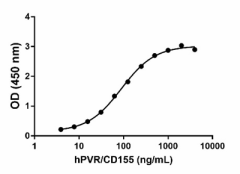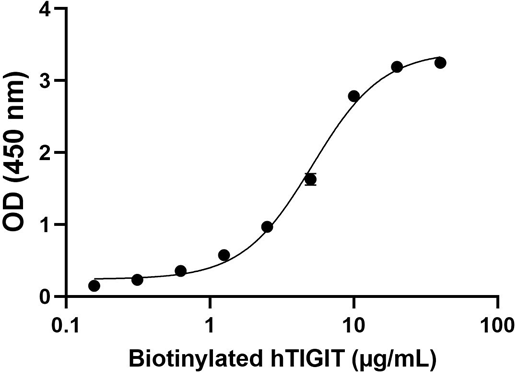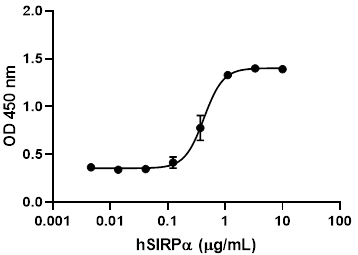- Regulatory Status
- RUO
- Other Names
- Poliovirus Receptor, PVS, Nectin-Like 5, NECL-5
- Ave. Rating
- Submit a Review
- Product Citations
- publications

-

Recombinant human CD155 binds to immobilized recombinant human TIGIT in a dose-dependent manner using a functional ELISA. The ED50 for this effect is 50 – 250 ng/mL. -

Stability Testing for Recombinant Human CD155. Recombinant human CD155 was aliquoted in PBS, pH7 at 0.2 mg/mL. One aliquot was frozen and thawed four times (4x Freeze/Thaw) and compared to the control that was kept at 4°C (Control). The samples were tested for their ability to bind to immobilized recombinant TIGIT in a dose-dependent manner using a functional ELISA. The ED50 for this effect is 50 – 250 ng/mL.
| Cat # | Size | Price | Quantity Check Availability | Save | ||
|---|---|---|---|---|---|---|
| 785202 | 10 µg | 90€ | ||||
| 785204 | 25 µg | 184€ | ||||
CD155 is a transmembrane adhesion protein that belongs to the immunoglobulin superfamily. It possesses three immunoglobulin-like domains, a transmembrane domain, and the intracellular domain. CD155 is encoded by eight exons and differential mRNA splicing results in four isoforms named PVRα, PVRβ, PVRγ, and PVRδ. The alpha and delta isoforms are membrane attached and the beta and gamma are soluble. The isoform PVRβ has a partial sequence and PVRγ lacks exon six, which codifies the transmembrane domain. The extracellular domain is identical in all the isoforms and binds to the polio virus; therefore, the soluble forms compete with the membrane attached isoforms for the binding of the virus. PVR/CD155 is expressed in multiple tumors such as colorectal, gastric, multiple myeloma, myeloid leukemias, ovarian cancers, and melanoma. CD266 is expressed in CTL and NK cells and binds to CD155 expressed in cancer cells; therefore, CD226 might contribute in the immunity against CD155+ cancer cells. High levels of soluble forms of CD155 (PVRβ and PVRγ) have been detected in the serum of patients with cancer; thus, sCD155 might be a useful biomarker in cancer progression.
Product DetailsProduct Details
- Source
- Human CD155, amino acid Asp28 - Apn343 (Accession # NM_006505) was expressed in 293E cells. The C-terminus contains TGSR + hIgG1-Fc+ 6His tag.
- Molecular Mass
- The 560 amino acid recombinant protein has a predicted molecular mass of approximately 61.8 kD. The DTT-reduced and non-reduced protein migrate at approximately 80 kD and 160 kD respectively by SDS-PAGE. The predicted N-terminal amino acid is Asp.
- Purity
- >96%, as determined by Coomassie stained SDS-PAGE.
- Formulation
- 0.22 µm filtered protein solution is in PBS pH7.2.
- Endotoxin Level
- Less than 0.1 EU per µg protein as determined by the LAL method.
- Concentration
- 10 and 25 µg sizes are bottled at 200 µg/mL. 100 µg size and larger sizes are lot-specific and bottled at the concentration indicated on the vial. To obtain lot-specific concentration and expiration, please enter the lot number in our Certificate of Analysis online tool.
- Storage & Handling
- Unopened vial can be stored between 2°C and 8°C for up to 2 weeks, at -20°C for up to six months, or at -70°C or colder until the expiration date. For maximum results, quick spin vial prior to opening. The protein can be aliquoted and stored at -20°C or colder. Stock solutions can also be prepared at 50 - 100 µg/mL in appropriate sterile buffer, carrier protein such as 0.2 - 1% BSA or HSA can be added when preparing the stock solution. Aliquots can be stored between 2°C and 8°C for up to one week and stored at -20°C or colder for up to 3 months. Avoid repeated freeze/thaw cycles.
- Activity
- Recombinant human CD155 binds to immobilized recombinant human TIGIT in a dose-dependent manner using a functional ELISA. The ED50 for this effect is 50–250 ng/mL.
- Application
-
Bioassay
- Application Notes
-
BioLegend carrier-free recombinant proteins provided in liquid format are shipped on blue ice. Our comparison testing data indicates that when handled and stored as recommended, the liquid format has equal or better stability and shelf-life compared to commercially available lyophilized proteins after reconstitution. Our liquid proteins are verified in-house to maintain activity after shipping on blue ice and are backed by our 100% satisfaction guarantee. If you have any concerns, contact us at tech@biolegend.com.
Antigen Details
- Structure
- Dimer
- Distribution
-
Endothelial cells, cancer cells, widely distributed.
- Function
- Regulator of the cell-mediated immune response, takes part in the transendothelial migration of leukocytes, mediates NK cell adhesion and activation. Acts as receptor of poliovirus.
- Interaction
- T cells, NK crlls, cytotoxic T lymphocytes (CTLs)
- Ligand/Receptor
- TIGIT, CD96, CD226.
- Bioactivity
- Recombinant human CD155 binds to immobilized recombinant human TIGIT in a dose-dependent manner using a functional ELISA.
- Cell Type
- Endothelial cells
- Biology Area
- Cancer Biomarkers, Cell Adhesion, Immuno-Oncology, Immunology
- Molecular Family
- Adhesion Molecules, Immune Checkpoint Receptors, Soluble Receptors
- Antigen References
-
- Mendelsohn CL, et al. 1989. Cell 56:855.
- Bottino C, et al. 2003. J Exp Med. 198:557.
- Oda T, et al. 2004. Biochem Biophys Res Commun. 319:1253.
- Tahara-Hanaoka S, et al. 2006. Blood. 107:1491.
- Sullivan DP, et al. 2013. Am J Pathol. 182:1031.
- Iguchi-Manaka A, et al. 2016. PloS One. 11(4): e0152982.
- Bowers JR, et al. 2017. Virus Res. 242:1.
- Gene ID
- 5817 View all products for this Gene ID
- UniProt
- View information about CD155 on UniProt.org
Related FAQs
- Why choose BioLegend recombinant proteins?
-
• Each lot of product is quality-tested for bioactivity as indicated on the data sheet.
• Greater than 95% Purity or higher, tested on every lot of product.
• 100% Satisfaction Guarantee for quality performance, stability, and consistency.
• Ready-to-use liquid format saves time and reduces challenges associated with reconstitution.
• Bulk and customization available. Contact us.
• Learn more about our Recombinant Proteins. - How does the activity of your recombinant proteins compare to competitors?
-
We quality control each and every lot of recombinant protein. Not only do we check its bioactivity, but we also compare it against other commercially available recombinant proteins. We make sure each recombinant protein’s activity is at least as good as or better than the competition’s. In order to provide you with the best possible product, we ensure that our testing process is rigorous and thorough. If you’re curious and eager to make the switch to BioLegend recombinants, contact your sales representative today!
- What is the specific activity or ED50 of my recombinant protein?
-
The specific activity range of the protein is indicated on the product datasheets. Because the exact activity values on a per unit basis can largely fluctuate depending on a number of factors, including the nature of the assay, cell density, age of cells/passage number, culture media used, and end user technique, the specific activity is best defined as a range and we guarantee the specific activity of all our lots will be within the range indicated on the datasheet. Please note this only applies to recombinants labeled for use in bioassays. ELISA standard recombinant proteins are not recommended for bioassay usage as they are not tested for these applications.
- Have your recombinants been tested for stability?
-
Our testing shows that the recombinant proteins are able to withstand room temperature for a week without losing activity. In addition the recombinant proteins were also found to withstand four cycles of freeze and thaw without losing activity.
- Does specific activity of a recombinant protein vary between lots?
-
Specific activity will vary for each lot and for the type of experiment that is done to validate it, but all passed lots will have activity within the established ED50 range for the product and we guarantee that our products will have lot-to-lot consistency. Please conduct an experiment-specific validation to find the optimal ED50 for your system.
- How do you convert activity as an ED50 in ng/ml to a specific activity in Units/mg?
-
Use formula Specific activity (Units/mg) = 10^6/ ED50 (ng/mL)

 Login / Register
Login / Register 













Follow Us